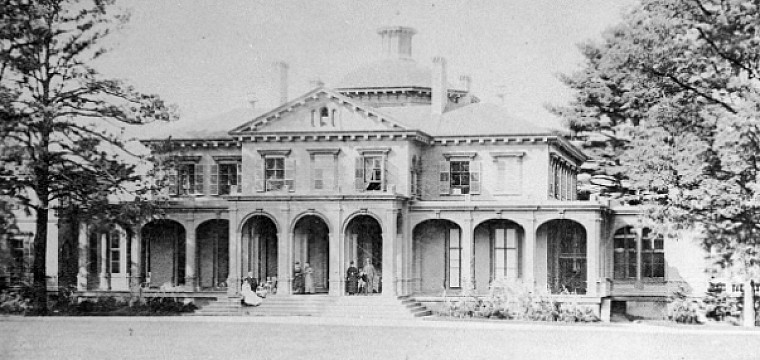Massena (1796)
Barrytown, Dutchess County, New York
Built 1796, for Major John R. Livingston (1755-1851) and his second wife, Eliza McEvers (1771-1810). Livingston had inherited most of the land that today constitutes Barrytown (once part of the Manor of Livingston granted to his ancestor in 1686), but he purchased the 200-acres on which he built his home from Peter Contine Jr. The mansion he built here was an exact copy of the Chateau de Beaumarchais in France and is named for one of Napoleon's most famous Generals, André Masséna (1758-1817), 1st Duke of Rivoli. It stood just north of his sister's property, Montgomery Place, and was built to plans drawn up by Sir Marc Isambard Brunel (1769-1849), the Chief Engineer of New York City and father of the famous Isambard Kingdom Brunel....

This house is best associated with...
The mansion featured a striking arcade with views over the terraced gardens, Hudson River and Catskill Mountains. Inside was included, "an octagonal library with carved black walnut bookcases, a dining room with a sea-green and gold frescoed ceiling, and a glass room extension or garden-parlor in winter.” Considered remarkable architecture in its day, Massena was often shown to art students as a model for them to copy, and it was here that Lorenzo Da Ponte - the Librettist who collaborated with Mozart and introduced Opera to the States - and his wife often spent their summers with their "dear friend" (John R. Livingston) and here they came to mourn the death of their eldest son in 1821.
In 1860, the 407-acre estate was purchased as a summer home for John Lloyd Aspinwall (1816-1873) whose brother bought Rockwood Hall in the same year. For the month of August in 1868, a young Theodore Roosevelt stayed here with his parents as guests of the Aspinwalls. Massena was considered, "one of the most beautiful homes in America" when it was destroyed by fire in 1885. Mrs Aspinwall employed William A. Potter to build a new home in its place that resulted in the Gothic brick and terra cotta mansion that stands in its place today. But, having been in Europe while it was built, she was appalled by what she saw when she returned, though duty (and dollars) compelled her to maintain it.
By 1912, Massena had been sold to Garrett Berg Kip (1877-1930) who lived here with his wife, Carola de Peyster (1882-1950). It was the Kips who sold Massena to the Christian Brothers. In 1928, John D. Rockefeller Sr. wanted to have a section of the Putnam Railroad diverted from East View to the north of his estate near Tarrytown, Kykuit. He struck a deal with the Brothers and in 1929 bought Massena and built the large brick school building in exchange for their property near to Kykuit. In 1974, the Unification Church bought the estate, opening the Unification Theological Seminary housed in Massena today.
In 1860, the 407-acre estate was purchased as a summer home for John Lloyd Aspinwall (1816-1873) whose brother bought Rockwood Hall in the same year. For the month of August in 1868, a young Theodore Roosevelt stayed here with his parents as guests of the Aspinwalls. Massena was considered, "one of the most beautiful homes in America" when it was destroyed by fire in 1885. Mrs Aspinwall employed William A. Potter to build a new home in its place that resulted in the Gothic brick and terra cotta mansion that stands in its place today. But, having been in Europe while it was built, she was appalled by what she saw when she returned, though duty (and dollars) compelled her to maintain it.
By 1912, Massena had been sold to Garrett Berg Kip (1877-1930) who lived here with his wife, Carola de Peyster (1882-1950). It was the Kips who sold Massena to the Christian Brothers. In 1928, John D. Rockefeller Sr. wanted to have a section of the Putnam Railroad diverted from East View to the north of his estate near Tarrytown, Kykuit. He struck a deal with the Brothers and in 1929 bought Massena and built the large brick school building in exchange for their property near to Kykuit. In 1974, the Unification Church bought the estate, opening the Unification Theological Seminary housed in Massena today.
You May Also Like...
Categories
Styles
Share
Connections
There is 1 member connected to this house, are you? Connect to record your link to this house. or just to show you love it! Connect to Massena (1796) →
Bruce Knox loves Massena (1796)






